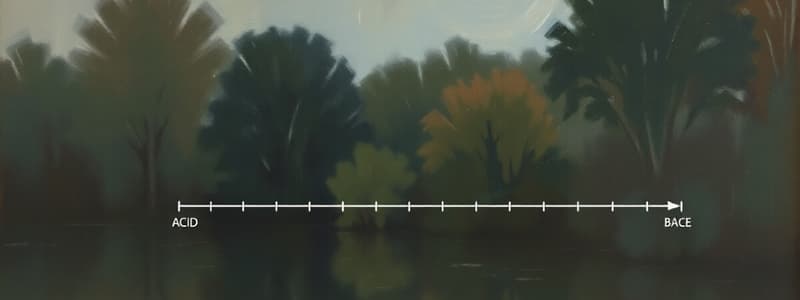Podcast
Questions and Answers
What is the pH level of a neutral solution?
What is the pH level of a neutral solution?
- 0
- 14
- 7 (correct)
- 3
Which of the following statements about acids is true?
Which of the following statements about acids is true?
- They decrease the concentration of free H+ in a solution.
- They have a pH greater than 7.
- They act as proton acceptors.
- Stronger acids dissociate more H+ than weaker acids. (correct)
Which of these describes a basic solution?
Which of these describes a basic solution?
- pH greater than 7 (correct)
- pH of 3
- Greater concentration of H+ than OH−
- pH of 7
What role do buffers play in the body?
What role do buffers play in the body?
What happens to the pH when H+ concentration increases?
What happens to the pH when H+ concentration increases?
How do stronger bases differ from weaker bases?
How do stronger bases differ from weaker bases?
What is the function of the kidneys in relation to the carbonic acid-bicarbonate buffer system?
What is the function of the kidneys in relation to the carbonic acid-bicarbonate buffer system?
Which of the following conditions is indicated by a low blood pH?
Which of the following conditions is indicated by a low blood pH?
Flashcards
pH
pH
A measure of hydrogen ion concentration in a solution, ranging from 0 to 14.
Acidic Solutions
Acidic Solutions
Solutions with a pH less than 7, having higher concentrations of H+ than OH−.
Basic Solutions
Basic Solutions
Solutions with a pH greater than 7, containing higher concentrations of OH− than H+.
Neutral Solution
Neutral Solution
Signup and view all the flashcards
Acid
Acid
Signup and view all the flashcards
Base
Base
Signup and view all the flashcards
Neutralization
Neutralization
Signup and view all the flashcards
Buffers
Buffers
Signup and view all the flashcards
Study Notes
Chapter 2: Atoms, Ions, and Molecules - Acids, Bases, and pH
- Learning Objectives: Define pH, differentiate acidity and basicity, compare and contrast acids and bases, and describe how buffers maintain blood pH in the carbonic acid-bicarbonate buffer system.
pH
- pH is a measure of the relative amount of H+ in a solution.
- The pH scale ranges from 0 to 14.
- pH and H+ concentration are inversely related. As H+ concentration increases, pH decreases. Conversely, as H+ concentration decreases, pH increases.
- A pH of 7 is neutral. pH values below 7 are acidic, and above 7 are basic.
- Each step on the pH scale represents a tenfold difference in H+ concentration.
pH and Solutions
- Neutral solutions have equal concentrations of H+ and OH-.
- Acidic solutions have a greater concentration of H+ than OH-.
- Basic solutions have a greater concentration of OH- than H+.
Acids
- Acids are proton donors, increasing the concentration of free H+.
- Stronger acids have a greater dissociation of H+ than weaker acids.
- Examples include hydrochloric acid (stomach acid) and carbonic acid (in the blood).
Bases
- Bases are proton acceptors, decreasing the concentration of free H+.
- Stronger bases absorb more H+ than weaker bases.
- Examples include ammonia and bleach. Bicarbonate is a weak base that buffers blood pH.
Neutralization
- Neutralization occurs when an acidic or basic solution is returned to a neutral pH (7)
- Acids are neutralized by adding a base.
- Bases are neutralized by adding acid. Example: Medications to neutralize stomach acid often contain a base.
Buffers
- Buffers help prevent major pH changes.
- The carbonic acid-bicarbonate buffer system is critical in maintaining blood pH within a narrow range.
- Carbonic acid (weak acid) and bicarbonate (weak base) act together to resist changes in pH.
- Blood pH is maintained at a critical range of 7.35-7.45.
- Low blood pH is acidosis, while high blood pH is alkalosis.
- Lungs regulate CO2, while kidneys regulate bicarbonate levels for proper pH balance.
Studying That Suits You
Use AI to generate personalized quizzes and flashcards to suit your learning preferences.




